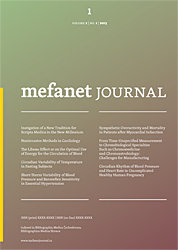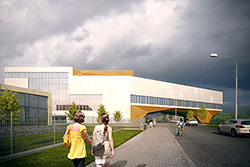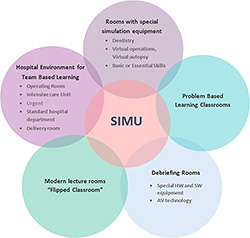
MEFANET Journal 2017; 5(2): 72-75
EDITORIAL MATERIAL
The simulation centre of European significance will be built in Brno
Jitka Blažková1, Michal Sellner1, Petr Štourač1,2
1 Faculty of Medicine, Masaryk University, Brno, Czech Republic
2 Department of Paediatric Anaesthesiology and Intensive Care Medicine, University Hospital Brno, Brno, Czech Republic
* Corresponding author: petr.stourac@akutne.cz
Abstract
The Ministry of Education Youth and Sports approved a unique project of Masaryk University to build a simulation centre for future physicians. The concept of the project was introduced on 8 June 2017 at a faculty conference which focused on the topic of reorganization of education and the Simulation Complex of Masaryk University.
The planned concept will fundamentally affect both present and future medical programmes. The Simulation Centre is unique by its complex view on medical curricula by incorporating the state-of-the-art elements of simulation medicine into ordinary teaching. Each room, simulator or learning aid will have a firm place in the learning process.
Keywords
Simulation; education; medical programmes; innovation; problem-based learning; team-based learning; virtual patient; debriefing; 21st century skills simulation centre
The Simulation Centre (SIMU) project aims to upgrade the teaching of MU medical programmes through the implementation of advanced features of simulation medicine into ordinary teaching.
During the project implementation (4/2017 – 9/2022), the curriculum will be revised with focus on the General Medicine and Dentistry study programmes. The planned revisions will overlap into the curricula of other non-medical programmes in future. Revisions will mostly impact the practical part of teaching, which will be expanded to include a comprehensive range of simulation teaching methods, using patient’s simulators, mannequins and virtual and standardized patients. Emphasis will also be placed on the development of soft skills, highlighting 21st century skills such as communication and decision-making skills, critical thinking, clinical reasoning, crisis communication and teamwork.
Introduction of these new teaching methods will place high demands on infrastructure equipment such as specialized lecture rooms, simulation of the hospital environment, high-fidelity simulators, etc. Consequently, a new buidling for the Simulation Centre will be constructed as part of the project in order to meet the above-mentioned spatial and material requirements.
SIMU is unique in:
- the scope and approach in the introduction of simulation methods into teaching,
- the standardization of teaching and its continuous assessment,
- the introduction of Objective Structured Clinical Examination (OSCE),
- the wide spectrum of simulation methods,
- increasing efficiency in practical training,
- the centralization of simulation methods into one location (simulation of hospital environment),
- the simulation of authentic hospital and pre-hospital environment,
- specialized equipment covering a wide range of pedagogical and simulation methods.
Simulation – new trend in education
Continuous development and innovation in modern medicine have steadily increased the volume of knowledge and the number of procedures with which the medical students must be acquainted. This compels lecturers to enrich and to expand the syllabus with new information and methods, thus greatly increasing the volume of teaching material. Although students are theoretically impeccably prepared, they often have difficulties in using the acquired knowledge in practice. At the same time, changes in the structure of healthcare mean that part of the inpatient care is transferred to the outpatient sphere and consequently, the time that students can spend in contact with patients has been increasingly limited. Students are merely in the role of observers, not being able to independently carry out tasks that they only know theoretically. Another problem is that the practical training of medical students takes place in faculty hospitals. Patients coming to medical facilities of this type usually have very specific and complex diagnoses, which are not suitable for teaching purposes. As a result, students lack training in basic skills, and their practical training may not be fully consistent with the theory currently being studied.
The SIMU project addresses these issues, focusing particularly on innovation, development and improvement of practical teaching.
Students who will complete the modified study process will have better practical skills, more experiences and a better ability of independent decision-making. They will be able to get involved in the working process more quickly and easily and their teamwork ability will improve.
Pedagogical methods planned in SIMU
We will not change what to teach but how to teach.
Problem-based learning / team-based learning
Problem-based learning represents a teaching style designed for a student who learns by developing his/her own solution(s) to a given problem. Compared to the traditional teaching method, its main advantages involve an effective solution of the problem and teamwork training. Working in groups, students discover what they really know, what they should know, and how and where to acquire more information that will help them solve the given problem. The lecturer’s role is not teaching but guiding the group towards the solution.
During the tutorial, students will be divided into small groups of 2–4 students. In these groups, they will examine a virtual patient (e.g. AKUTNĚ.CZ, Sepsis-Q.cz, or branched virtual patients authored in Open Labyrinth) node by node, and they will jointly discuss and select a suitable procedure, which will be subsequently presented and defended before the whole group. The lecturer will act as a discussion facilitator, guaranteeing the accuracy and completeness of the pathophysiological mechanisms and supplementing the outcomes with clinical context.
Virtual patient
Virtual patient is an interactive computer simulation of a real clinical situation or a case created for medical and health education purposes. It supports the acquisition and training of skills such as clinical decision-making, clinical reasoning and critical thinking. Virtual patients facilitate self-directed learning and enable students to prepare for lectures or other teaching/learning sessions. Any incorrect options taken during the management of a virtual patient leads to an explanation; the student always receives an immediate feedback.
Simulation
Simulation is one of the most progressive forms of teaching because it has clearly definable and measurable objectives. Simulation makes it possible to practise repeatedly. It also provides the option of making mistakes without any consequences, which, in real life, could be fatal. In a simulation, mistake is considered as an opportunity to learn.
As part of the feedback (debriefing), the student's approach is discussed and its strengths and weaknesses are assessed. A detailed analysis of different key situations arising during the simulation is an important part of debriefing; audio-visual recording is edited in real time and tagged using key marks. The lecturer’s personality is an important factor. Lecturers must be fully competent in solving the given clinical situations and must be familiar with strengths and limitations of any simulation media that will be used in teaching.
Vision of the Simulation Centre
Through the involvement of advanced elements of simulation medicine in education, the Simulation Centre aims to become the leading workplace in the field of medical education in the Czech Republic.
“We knew what the student went through ...
... now we will know how the student has gone through.”
Acknowledgments
This work was supported by projects Masaryk University Strategic Investments in Education SIMU+ (CZ.02.2.67/0.0/0.0/16_016/0002416) from European Regional Development Fund and Masaryk University 4.0 (CZ.02.2.67/0.0/0.0/16_015/0002418) from European Social Fund.
Please cite as:
Blažková J, Sellner M, Štourač P. The simulation centre of European significance will be built in Brno. MEFANET Journal 2017; 5(2): 72-75. Available at WWW: http://mj.mefanet.cz/mj-20170627.
This is an open-access article distributed under the terms of the Creative Commons Attribution-NonCommercial-ShareAlike 3.0 License (http://creativecommons.org/licenses/by-nc-sa/3.0/), which permits unrestricted use, distribution, and reproduction in any medium, provided the original work, first published in the MEFANET Journal, is properly cited. The complete bibliographic information, a link to the original publication on http://www.mj.mefanet.cz/, as well as this copyright and license information must be included.












